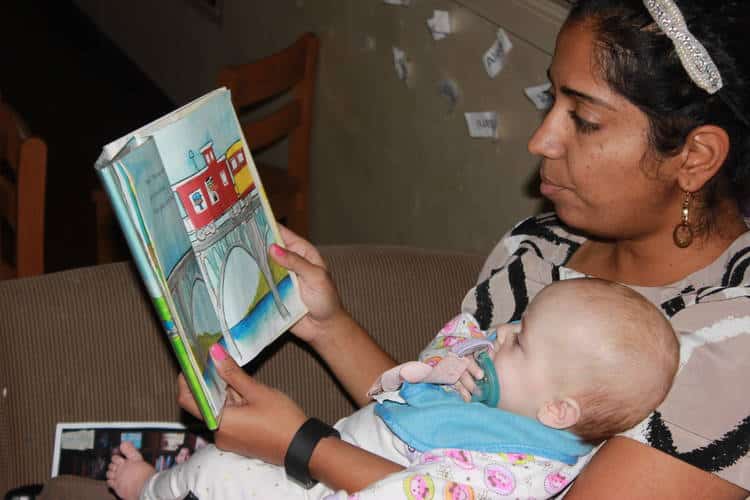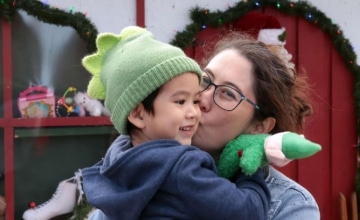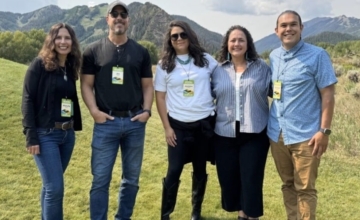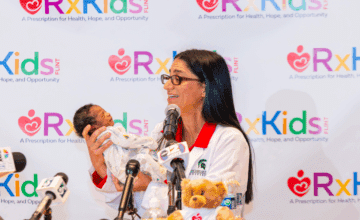Anneliese W. Johnson and Samantha Peterson, The Ohio State University
Abstract
How do very young children develop a sense of identity and belonging culturally, and how can this sense be supported by early care and education teachers and programs? This article examines literature associated with identity and belonging in early childhood and how those who work closely with children and families can incorporate best practices into daily routines and procedures. The authors share several practices from the A. Sophie Rogers School for Early Learning at The Ohio State University, a high-quality program serving children and families who are economically and culturally diverse.
Elizabeth is a 19-month-old toddler who attends our early care and education program full-day, full-year while her parents work. Her family, including siblings, primarily speak Spanish at home, as do several other of the schools’ students. As such, the school has made a concentrated effort to employ teachers who are native Spanish speakers or otherwise fluent in Spanish. When Elizabeth arrives for the day, she is greeted enthusiastically with phrases in Spanish and English from her peers and teachers. Spanish phrases and words make up the environmental print throughout the room. Laminated notecards are displayed prominently for all children and teachers to access; the cards contain phrases supplied by Elizabeth’s parents for commonly used routines and classroom rituals such as “Do you want to use the bathroom now or in 5 minutes? ¿Quieres usar el baño ahora o en cinco minutos?” and “We wash our hands before we eat. Nos lavamos las manos antes de comer.” Children frequently carry these card packs around the room to “read,” and teachers read them in English and Spanish and point to the words when providing one of the directives. Photos of all the children’s families, and of the teachers and their families, are displayed on the walls and in small frames throughout the classroom. Similarly, each child has a small photo album with photos supplied by families and/or taken by teachers at school of children’s families, friends, and pets. Children carry and use the photo albums throughout the day, often taking them from their display in a basket in the reading area to their cubbies and other personal spaces to review.
At this morning’s drop off, Elizabeth is feeling sad as her mother leaves for her workday. The teacher says “We will miss Mommy when she is at work. Let’s get her picture to look at and we can write her a note. Esta bien que extrañes a Mamá cuando ella esta en el trabajo. Vamos a ver su foto y podemos escribirle una nota.” The other children in the classroom notice Elizabeth is sad, and the other teacher says, “Una nota. Elizabeth is writing her mommy una nota” and shows the other children the writing area where children can write small notes to parents and vice versa, interspersing Spanish and English, and reads the card aloud that has been transcribed to the teacher.
Identity Development Begins at Birth
Parents and caregivers may not give much thought to their baby’s developing sense of identity while they are overwhelmed with the daily tasks of infant–toddler care and support. Much of the research focused on child identity and the developing sense of self is centered on middle childhood and adolescence, which is when most people expect children to individualize and become their own person (Bennett, 2011). In fact, as soon as they are born, babies are undergoing this process and making sense of the world around them using social relationships to guide their learning. In an increasingly diverse population, this process may place children in the care of educators whose culture, values, and norms are vastly different from those experienced at home. At the same time, early childhood programs, especially those which serve children at-risk and are subsidized by state or federal funds, are experiencing increasing regulation and accountability which often results in standardization. How can early childhood teachers and administrators support and celebrate the diversity of the children within classrooms while also developing a cohesive classroom and infant–toddler community of learners?
The Importance of Relationships
Erikson was among the first to examine how children’s sense of identity and character developed, and he proposed a stage theory to explain how young children and later adolescents and adults progress in life span development (McLeod, 2008). For children less than 36 months old, there are two stages identified by Erikson: Trust vs. Mistrust, which encompasses the first 18 months of life, followed by Autonomy vs. Doubt, which includes ages 18 to 36 months. Both stages are influenced heavily by the types of environments and support a very young child receives. During the Trust vs. Mistrust stage, infants learn whether they can trust that their needs will be met by caring and competent adults and caregivers; those whose needs are not consistently or adequately met will be insecurely attached and suffer later in developing secure and stable relationships. Similarly, in the Autonomy vs. Doubt stage, children begin to test their abilities and competencies; those who are supported and provided an opportunity to explore will grow to be industrious and independent. Children with overly controlling or anxious caregivers will not develop the fortitude to persevere and learn autonomously.
Explicit in both of Erikson’s stages during infant–toddler development of self is the tremendous role of caregivers and parents in how the child’s identity is formed. One of the most fundamental goals that we have for the infants and toddlers in our program is that each establish a strong, secure relationship with a teacher in his or her classroom. This development of trust is a critical foundation for a child’s later understanding of who she is and how she fits into the social world around her. One of the ways we help infants and toddlers develop a sense of trust is by establishing primary caregivers for each infant and toddler in our school. One teacher from the staff of three in each classroom will be partnered with a child upon enrollment and is responsible for the child’s daily routines, family updates, and screenings and assessments. Although any teacher will appropriately meet the needs of each child throughout the day, the primary caregiver is the acknowledged “expert” on a particular child and makes a concerted effort to bond and have special time with their primary care group each day. The primary caregiving teacher takes the lead on supporting developmental milestones such as transitioning to solid foods, walking, and toilet training and is a primary point of contact for families for conferencing and communication purposes.
Cultural and Societal Influences on Child Development
Bronfenbrenner later expanded stage theory to include a complex system of cultural and societal influences on child and adult development in his Ecological Models of Human Development (Bronfenbrenner, 1994). Bronfenbrenner’s model examines social systems which influence child development in terms of levels based upon those which the child encounters daily and interpersonally and those which permeate development more indirectly. The role of the parent and/or early childhood educator of a child is critical and inextricably linked in both Erikson’s and Bronfenbrenner’s theories. According to Erikson, a child who is not getting his needs consistently met by a caring adult will suffer greatly during the Trust vs. Mistrust stage. A child whose parents are letting him “cry it out” through the night but is being swaddled and held throughout naptime at child care is receiving inconsistent and confusing messages which makes navigating this stage successfully even more of a challenge. Similarly, in the Autonomy vs. Doubt stage, a child whose parents let her explore and try new things at home but who at child care is kept to a small room with the same materials and rigid schedule day after day would also experience a similar sense of confusion.
Bronfenbrenner’s model also includes parents and teachers at the same Microsystem level; that is, they both have daily and direct influence on how a child interacts and develops socially in the world. In both models, having families and caregivers on the same page and supportive of each other and their child-rearing efforts serves to bolster a child’s development and navigation of these important stages of development of self. One way that our school helps families and teachers to engage in clear and consistent dialogue is ensuring a permanent staff member open and close a classroom daily, rather than “collapsing” classrooms as children and teachers leave or having substitutes end the day. Having a consistent presence in the classroom provides face-to-face communication and opportunities for discussion. Often miscommunications, questions, and assurances are easily sorted out through daily check-ins and concerted efforts by teachers to engage families in conversation each day in the morning and afternoon. Permanent staff who have been with the children for the majority of the day are also more equipped to answer questions about daily routines and experiences throughout the day.
These established theories emphasized the important nature of the relationships infants and toddlers have with those providing primary care and education to them. For children who are cared for outside of the home, typically in group early education and care settings, it is important that there is consistency and routine established between home and school, and that educators and families communicate and have an understanding of family and school culture.
Bridging Home and Classroom Culture
Classroom and group identity form in the school through classroom routines and rituals around arrivals, departures, mealtimes, and toileting. These daily routines help children to understand and predict what is going on around them, support the development of classroom culture, and provide the consistency that is critical in supporting children to feel safe and secure in their environments (Harms, Cryer, & Clifford, 2006; Spagnola & Fiese, 2007). Within a safe group setting, children begin to develop their own classroom or peer culture; this is the language, routines, and rituals that children themselves develop with each other while in group contexts, although these may be heavily influenced by the adults who are a part of the group setting as well (Corsaro, 2009). Peer culture develops in such a way that each school, classroom, and smaller groups of peers within classrooms cultivates its own set of explicit and implicit rules and expectations. For instance, our entire school uses the phrase “make a plan” to initiate and support sharing behaviors between children. However, classrooms may have different routines and expectations around activities such as mealtimes based upon the current make-up of the classroom (e.g., perhaps a classroom with more very young infants has a less autonomous snack time than a classroom with several older toddlers). Even within classrooms, toddlers form their own peer culture routines and rituals that indicate belonging and knowing. Toddlers who want to play rough and tumble ideas will navigate to the mat area of a classroom, and it is implied that those who join in that space are also looking to run, jump, and roll. School culture, classroom culture, and peer culture are all opportunities for children to share in common acts and knowledge with others, contributing and building their sense of identity and belonging. Children are social beings and enjoy shared experiences and learning with peers and caregivers. Positive classroom experiences contribute to the development of an understanding of themselves as competent and significant. The simple act of singing songs and other typical group time activities further strengthen the relationships children develop in school and support their developing sense of belonging and social identity, that is, the sense of themselves in relation to others (Bennet 2011; Niland, 2015).
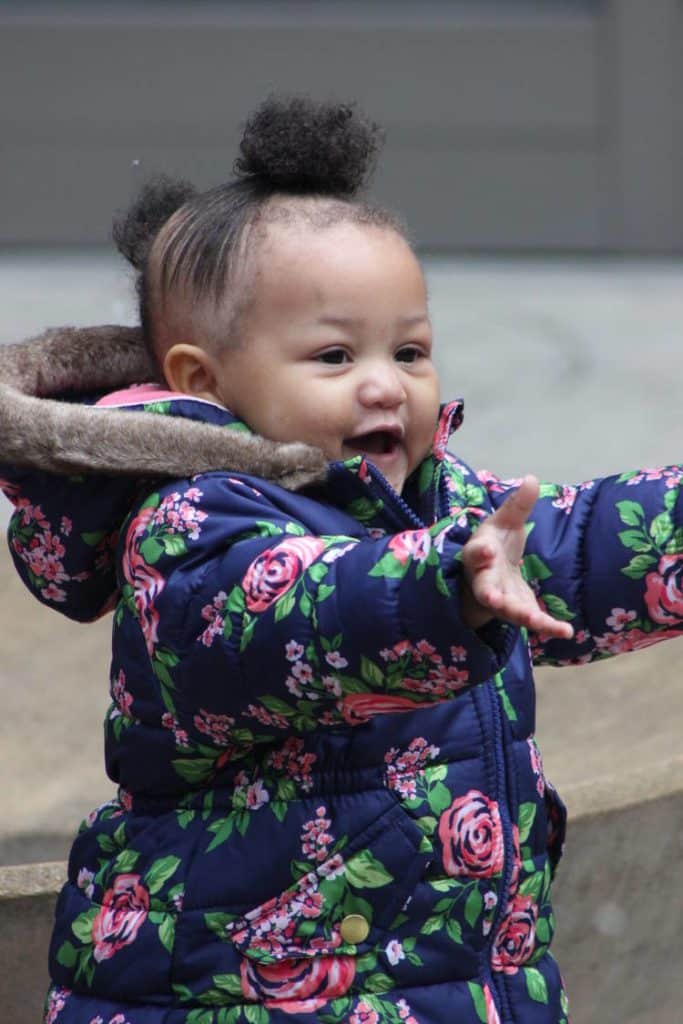
Classroom and group identity form in the school through classroom routines and rituals around arrivals, departures, mealtimes, and toileting. Photo: Courtesy of the A. Sophie Rogers School for Early Learning
Because those in intimate roles with infants and toddlers impact their sense of identity and belonging so greatly, it is imperative that the classroom and school culture reflect and honor the home cultures of its many students while also developing its own unique culture and practices within the learning community. Cultural and family tradition take on unique meaning when working with infants and toddlers. Very young children can distinguish between male and female faces and different languages and will often show preference for that which is familiar. However, family cultural, religious, and ethnic values, which have more of a verbal transmission, may not yet be internalized by an infant or even experienced by a child (Bennett, 2011).
Oftentimes, early childhood programs attempt diversification by adding images or posters of non-dominant cultures or other tangible artifacts such as ethnic art. These items may be meaningful in a classroom context and encourage language and conversation, however, identifying and supporting family practices and traditions provides meaningful opportunities to enhance the environment and the learning activities which benefit all children in the program (Nieto, 2002). Therefore, it is important that early childhood settings not only add images and celebrate non-dominant holidays, but also take into consideration how families structure their own routines such as eating, sleeping, and speaking with their young child.
Moreover, a well-meaning classroom which focuses on adding artifacts, images, and holidays to its environment may be missing the point of cultural empowerment by creating a “tourist” approach to other cultures and which only serves to emphasize the well-known holidays, dress, or famous individuals of a group (Mangione, 1995). While tangible cultural artifacts and celebrations can be one aspect of cultural sensitivity, it is even more important that an early childhood program create and foster a language of respect, understanding, and welcoming. Although there may be differences in care and routines, establishing a rapport and relationship with families which encourage dialogue and discourse and allow for flexibility is the true key to supporting diverse children and families in the classroom. All families develop systems and rituals around the intimate daily care tasks of infants and toddlers, and, considering the established impact of family and school ecology and relationships on a developing child’s sense identity, it is critical that early childhood educators make every effort to provide pathways for communication and understanding between classrooms and families.
The A. Sophie Rogers School for Early Learning
Taking the time to build relationships with all families enrolled in diverse schools supports teachers, families, and children. Empirical evidence indicates that children’s development within early childhood classrooms is affected by the skills of their classmates; children who are less skilled due to environmental disadvantage or disability can benefit greatly by being surrounded by highly skilled classmates (Justice, Logan, Lin, & Kaderavek, 2014).
The A. Sophie Rogers School for Early Learning had previously been located on The Ohio State University’s campus and was viewed as a typical laboratory school where all families paid tuition and were within the same socioeconomic income bracket. The School for Early Learning was purposefully moved to an area historically deemed one in need and located just south of the University, especially to support the large amount of low-income families with young children under 5 years old.
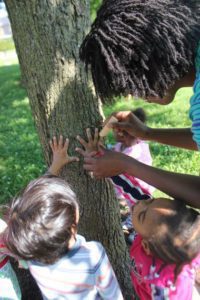
Children are social beings and enjoy shared experiences and learning with peers and caregivers. Photo: Courtesy of the A. Sophie Rogers School for Early Learning
Accessing high-quality early childhood programming is unfortunately out of reach for many families. There is a disproportionate number of minority families living in poverty (Jiang, Granja, & Koball, 2017) and having children all from the same socioeconomic background provides little diversity within the classroom. When the School for Early Learning was on campus, there was much diversity ethnically and racially, being affiliated with the University, but there was not diversity socioeconomically. The move to the Weinland Park neighborhood in Columbus, Ohio, allowed the School to expand its diversity to socioeconomic status as well.
The cost for high-quality early childhood education is often unattainable for many families that live at or below the federal poverty level. Prioritizing a mixed-income model ensures that a diverse population of families are able to come together and receive the same schooling regardless of income level. The use of multiple funding streams ensures a mixed-income model and helps support children and their families by partnering with local and federal agencies. While the requirements to meet local and federal guidelines can take a lot of administrative time, the benefits of having a mixed-income model are crucial to supporting diversity and inclusion of all families. This can be done by leveraging existing local, state, and federal funding to support school operations. But it doesn’t end there; families should feel welcomed and “heard” when enrolling their child in an early childhood school.
Partnering With Families
Prior to enrolling in the A. Sophie Rogers School for Early Learning, families meet with the assistant principal and the classroom teachers. This process allows the parents (or guardians) to share important information regarding their family and their child (see Box 1). Teachers use a guided questionnaire that parents answer in a natural flow, highlighting important points for the family with the teacher. Teachers ask specific questions related to home life such as, who resides in the home or whom the child spends time with, religious and cultural preferences, types of foods eaten, languages spoken in the home, child’s areas of interest, and how involved parents wish to be in the day-to-day experiences of the classroom. All of these can be used to gain a better understanding of a typical day in the life of the child. By sharing this information prior to a child enrolling in school, the teachers can then add or create a classroom environment that has familiar surroundings to the child (Richards, Brown, & Forde, 2007). Teachers intentionally set up their classroom environment to be representative of the children and families that are enrolled; also including their own backgrounds and culture throughout the space. Being purposeful and mindful of the children in the school and having materials and books that are representative of those families is vital to bridging the home–school gap and providing a space where children feel comfortable to freely express themselves (Durden, Escalante, & Blitch, 2015).
Family-centered programs share the following characteristics (Witmer & Petersen, 2010):
• supporting the relationship between the child and his or her family
• making family members feel welcome through positive attitude and environment
• involving families in the programming
• establishing a system for daily and thorough information
• providing continual support for families to express their feelings, values, and concerns as their child grows and develops
These ideals are critical for high-quality care and education for all children, but in particular for infants and toddlers from a non-dominant culture whose identity and attachment development may be at-risk if careful consideration is not taken to be respectful of home culture (Gonzalez-Mena, 2001). An appealing manner to learn more about infants and toddlers is to invite parents to share transition day(s) with the program. This can be a time where a parent and child attend the classroom prior to being fully enrolled, or when parents are invited to spend several hours alongside the teachers for a day so that the teachers who will assume caregiving for the child can learn from the parent how the child likes to be put to sleep, how she takes a bottle, and how she signals that she needs a diaper change. Transition visits with family members can also be a time when families and teachers discover any potential differences in care routines and provide an opportunity for discussion, understanding, and compromise (Gonzalez-Mena, 2008).
By incorporating images and practices familiar to students, teachers can capitalize on the strengths students bring to school; using the physical environment builds authentic classroom experiences and interactions (Richards et al., 2007). Teachers can show their inclusion of the families by displaying familiar words and phrases throughout the classroom environment in the families’ native languages and incorporating the native language into everyday conversations. The vignette in the beginning of this article gave the example of how the teacher included Elizabeth’s native language of Spanish into the conversation and addressed her feelings to the other children present. This dialogue emphasized the importance of all languages and exposed children, who may not be native Spanish speakers, to the idea that there are many ways in which to communicate with one another.
As young children are playing in the dramatic play area, teachers can place culturally relevant clothing, blankets, and décor in the space and discuss how these materials are being used and their importance (Bredekamp, 1997). Teachers can use developmentally appropriate interactions to explore many different backgrounds and cultures, as well as children with varying needs (e.g., wheelchairs, leg braces, glasses). Materials might include dolls that are representative of all family structures, photos and other materials at the children’s eye level—rather than on a wall or shelf—that “show” diversity within in the classroom, and family photos arranged aesthetically around the room.
Encouraging families to actively participate in their child’s education by inviting them to spend time in the classroom is another way to show the importance of family collaboration and inclusiveness. It is important to communicate with families daily about their child’s interests and also to find out the caregiver’s interests. Ask caregivers to share their knowledge with the classroom. This could be accomplished by having the family bring in a favorite food, create an art project, read stories, sing a song, or simply volunteer in the school office. These efforts show that the school values the family and looks at the family as a partner. Children can begin to see their families are having meaningful interactions within their school and are building relationships with the school and their teachers. Children’s interactions and relationships support their sense of belonging, which in turn supports the development of social identity (Bennett, 2011).
Building Community
The A. Sophie Rogers School for Early Learning collaborates with the university whenever possible. As the model demonstration site for the College of Education and Human Ecology, undergraduate and graduate students have the opportunity to use the observation deck at the school to watch the children, teachers, and families interact with one another. College students are also placed directly in the classrooms as part of their coursework and work alongside the children and teachers. Members of outside disciplines, including social work interns, marriage and family therapy interns, and speech–language pathologists, are also involved in the school team and aid in supporting all families no matter what their socioeconomic background. These individuals are on-site and work directly with the administration and teachers to support families and bring them together in ways their everyday lives may not have. The principal and assistant principal ask families to complete questionnaires at the beginning of each school year to assist in determining topics for the Parent Education series for the year. This input allows families’ interests to be heard and offers a way for the school community to come together. The school began a Family Storytime with the school librarian and social work intern once a week for parents to network with one another, spend time with their children at the school, and have the opportunity to interact with the social work intern to support their needs. All of this contributes to the families building a sense of community with not only other families but with the school community as well. Even though the families are from varying socioeconomic backgrounds, they are growing and learning together and have the opportunity for their children to learn from other families that may be unlike their own.
Conclusion
Children are increasingly being cared for outside of the home while one or both parents work. At the same time, the diversity of the United States and the ability to communicate instantly using technology has created pathways for progressive communication and insight. Although providers have an understanding about how it feels best to support and engage with diverse families in early childhood programs, there is still a need to support research in responsive care and education in infant–toddler programming specifically, including its impact on identity and self-development and still later academic success. In order to teach diverse student populations, secondary education and teacher training programs must ensure that coursework emphasizes and explicitly teaches cultural sensitivity and responsive education for an impact and appropriate changes to be seen in classroom practice (Goldstein, 2003). Namely, success has been found in professional development which explicitly illustrates the differences in individualism and collectivism in various cultures, and how this may impact a classroom environment or interactions with parents and children (Rothstein-Fisch, Trumbull, & Garcia, 2009). Cultures which value group settings and community may not find it critical that an infant eat independently or sleep alone in a crib, whereas infant programs in the United States may tend to support these outcomes and view them as a success of a child’s autonomy. The individualism vs. collectivism continuum is so prevalent in daily routine and care tasks of infants and toddlers (sleeping, eating, walking, carrying, and speaking) that supporting education and understanding about this cultural difference predictably fosters dialogue and awareness among teachers. In addition to the importance and sensitivity of the pre-service educator’s curriculum and content, the diversity of instructors in early childhood teacher training programs is significant. Diverse instructors are predictive of coursework which was more culturally relevant and sensitive and supported students to think crucially about their role in families’ lives and to continue working with children from different backgrounds (Lim, Maxwell, Able-Boone, & Zimmer, 2009). Attracting diverse candidates and supporting their continued commitment to children and families in the field will positively impact the workforce and classroom in early childhood education. At our early education program, families see their own cultures and languages reflected in the teaching staff and student teachers who work with their children. Evidence of collaboration and communication among diverse teachers is seen through everyday interactions and smooth classroom management as well as classroom documentation. Celebrating diversity and collegiality is evident between the families and teachers, and among the school staff, creating a welcoming and positive environment for everyone associated with the school.
Authors
Anneliese W. Johnson, MS, is the principal of A. Sophie Rogers School for Early Learning in the College of Education and Human Ecology at The Ohio State University. The school is dedicated to a mixed-income, mixed-age-grouping model of education for children birth to 5 years old and is the model demonstration site for the college. In her work, Johnson supervises educators and preservice teachers, and she seeks funding and enrollment pathways to support families living in poverty in attaining high-quality early childhood education. Johnson has presented locally and nationally on early childhood topics such as play, language and literacy, classroom management, the Reggio Emilia Approach, and working with children and families who have experienced trauma. Johnson has a master’s degree in human development and family science from The Ohio State University, and has spent her career in Columbus, Ohio. Although she has been in the field more than 20 years, her 10 years as a preschool teacher in the classroom are the most important in informing her work today with diverse children and families.
Samantha Peterson, MS, is the assistant principal at the A. Sophie Rogers School for Early Learning in the College of Education and Human Ecology at The Ohio State University at the Ohio State University. Peterson supports the delivery of innovative, evidence-based curriculum and systematic documentation and assessment of learning for all infant–toddler and preschool classrooms and serves as the literacy coach for the school. In her role, Peterson provides direct supervision of classroom teaching staff and supports teachers in behavior guidance, problem solving, and development of teaching strategies and supports teachers and families through referral processes. She oversees enrollment of children, parent communication, and compliance paperwork for families. Peterson works with many of the ancillary staff, speech–language pathologists, undergraduate and graduate student placements in marriage and family therapy and in social work, volunteers, and others and coordinates their time at the school and communicating information back to families as needed. She has co-authored a white paper on Blending Funding Streams in Early Childhood Education: Case Study of the A. Sophie Rogers School for Early Learning in 2015 and a literacy supplement manual specifically for infants and toddlers. Peterson has also presented on various topics at local conferences in Ohio, as well as at the annual conferences of the National Association for the Education of Young Children and ZERO TO THREE.
Peterson holds a master’s degree in human development and family sciences, with a concentration in early childhood development and education, from The Ohio State University. She has also held an early intervention certificate from the state of Ohio and serves as a stakeholder for the ACHIEVE grant through the Health and Rehabilitation Science department at the Ohio State University. She assists with the grant for children with cerebral palsy (CP) regarding dosing in children with CP, participates in panel discussions with the team, performing community outreach, and providing teacher perspective and knowledge of educational needs during infancy, preschool, and kindergarten readiness.
Suggested Citation
Johnson, A. W., & Peterson, S. (2019). Supporting individual and community identity development in infant–toddler classrooms. ZERO TO THREE Journal, 39(3), 18–24.
References
Bennett, M. (2011). Children’s social identities. Infant and Child Development, 20(4), 353–363.
Bredekamp, S. (1997). NAEYC issues revised position statement on developmentally appropriate practice in early childhood programs. Young Children, 52(2), 34–40.
Bronfenbrenner, U. (1994). Ecological models of human development. International Encyclopedia of Education, 3(2), 37–43.
Corsaro, W. A. (2009). “Peer culture.” In The Palgrave handbook of childhood studies (pp. 301–315). London, UK: Palgrave Macmillan.
Durden, T. R., Escalante, E., & Blitch, K. (2015). Start with us! Culturally relevant pedagogy in the preschool classroom. Early Childhood Education Journal, 43(3), 223–232.
Goldstein, L. S. (2003). Preservice teachers, caring communities, and parent partnerships: Challenges and possibilities for early childhood teacher education. Journal of Early Childhood Teacher Education, 24(1), 61–71.
Gonzalez-Mena, J. (2001). Cross-cultural infant care and issues of equity and social justice. Contemporary Issues in Early Childhood, 2(3), 368–371.
Gonzalez-Mena, J. (2008). Diversity in early care and education: Honoring differences. New York, NY: McGraw-Hill.
Harms, T., Cryer, D., & Clifford, R. M. (2006). Infant/toddler environment rating scale. New York, NY: Teachers College Press.
Jiang, Y., Granja, M. R., & Koball, H. (2017). Basic facts about low-income children children under 6 years, 2015. New York NY: National Center for Children in Poverty, Columbia University Mailman School of Public Health.
Justice, L. M., Logan, J. A., Lin, T. J., & Kaderavek, J. N. (2014). Peer effects in early childhood education: Testing the assumptions of special-education inclusion. Psychological Science, 25(9), 1722–1729.
Lim, C. I., Maxwell, K. L., Able-Boone, H., & Zimmer, C. R. (2009). Cultural and linguistic diversity in early childhood teacher preparation: The impact of contextual characteristics on coursework and practica. Early Childhood Research Quarterly, 24(1), 64–76.
Mangione, P. L. (1995). Program for Infant/Toddler Caregivers. Infant/toddler caregiving: A guide to culturally sensitive care. Sacramento, CA: Bureau of Publications, Sales Unit, California Department of Education.
McLeod, S. A. (2008). Erik Erikson | Psychosocial stages—Simply psychology. Source
Nieto, S. M. (2002). Profoundly multicultural questions. Educational leadership, 60(4), 6–10.
Niland, A. (2015). “Row, row, row your boat”: Singing, identity and belonging in a nursery. International Journal of Early Years Education, 23(1), 4–16.
Richards, H. V., Brown, A. F., & Forde, T. B. (2007). Addressing diversity in schools: Culturally responsive pedagogy. Teaching Exceptional Children, 39(3), 64–68.
Rothstein-Fisch, C., Trumbull, E., & Garcia, S. G. (2009). Making the implicit explicit: Supporting teachers to bridge cultures. Early Childhood Research Quarterly, 24(4), 474–486.
Spagnola, M., & Fiese, B. H. (2007). Family routines and rituals: A context for development in the lives of young children. Infants & Young Children, 20(4), 284–299.
Witmer, D. S., & Petersen, S. H. (2010). Infant and toddler development and responsive program planning: A relationship-based approach. New York, NY: Pearson.

